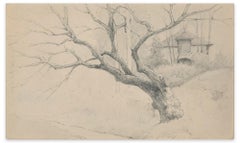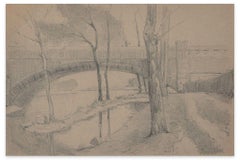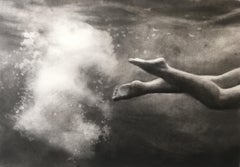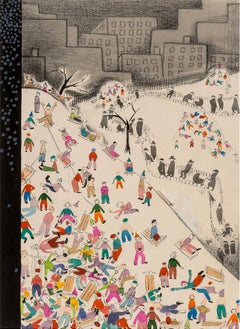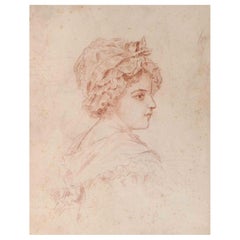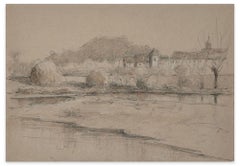Emile-Louis Minet Art
to
2
Overall Width
to
Overall Height
to
2
1
1
2
2
1
2
2
2
9,962
2,753
1,376
1,373
Artist: Emile-Louis Minet
Tree and House - Charcoal by E.-L. Minet - Early 1900
By Emile-Louis Minet
Located in Roma, IT
Tree and House is a precious pencil study realized by the French painter Emile-Louis Minet. The state of preservation is excellent. The piece of paper comes from a sketchbook, and it...
Category
Early 1900s Naturalistic Emile-Louis Minet Art
Materials
Charcoal, Pencil
Bridge on the River - Charcoal and Pencil by E.-L. Minet - 1919
By Emile-Louis Minet
Located in Roma, IT
Bridge on the River is a beautiful drawing in pencil and charcoal realized by the French painter Emile-Louis Minet in 1919. The state of preservation is very good, except for a small...
Category
1910s Naturalistic Emile-Louis Minet Art
Materials
Charcoal, Pencil
Related Items
Trailblazer by Patsy McArthur, charcoal drawing, underwater diver and bubbles
By Patsy McArthur
Located in Dallas, TX
Scottish artist Patsy McArthur explores the grace and power of human movement in her naturalistic drawings and paintings. Her latest works, including small ink studies, charcoal and ...
Category
2010s Realist Emile-Louis Minet Art
Materials
Charcoal, Archival Paper
$2,400
H 25.99 in W 38.59 in D 1.58 in
Children Snow Sledding in Central Park - New Yorker Cover Study
Located in Miami, FL
Hungarian/American artist/illustrator depicts a charming scene of sledding in the snow in Central Park. The work is abstract in its design as it's functional in its narrative - Unpublished New Yorker...
Category
1940s Modern Emile-Louis Minet Art
Materials
Charcoal, Ink, Watercolor, Gouache, Pencil
$15,000
H 16.85 in W 12.25 in
Niagra Falls Spring and Winter Watercolor Landscapes
By Maude Leach
Located in Houston, TX
Original watercolor landscape painting of Niagra falls in the winter and in the spring. The pair of paintings are signed by the artist in the bottom corne...
Category
20th Century Naturalistic Emile-Louis Minet Art
Materials
Watercolor
$1,800
H 22 in W 31.5 in D 1 in
View of Dunoon on the Clyde, Scottish landscape and Figures, 19th Century
Located in Hillsborough, NC
Scottish artist Robert Carrick (1829-1904) is renowned for his landscape and figurative paintings in oil and watercolor. This painting features detailed drawings of figures in the foreground with wagon, and the town and scenery in the background, painted over in watercolor in rich raw umber and red-brown tones in the foreground and blue green tones in the background.
Carrick showed promise at a young age, exhibiting his work at the Royal Academy age 16. He was a member of the Royal Institute. This two-toned watercolor work has detailed figures, wagon with hay in the forefront above a view of Dunoon town near Glasgow as it was long ago. Signed by the artist, lower left with an inscription that reads: 'View of Dunoon, Argyllshire drawn by Robert Carrick, Glasgow, for David Allan'. Verso includes a copy of the same inscription.
Saltire Gallerie replaced the cracked and dirty plain glass with art glass and added an acid-free paper behind the work. While doing this work we found an art giclee, included with the painting.
Presented in a patterned wooden frame with art glass. Dunoon was a thriving town on the river at the time of this work, and later became part of Glasgow. The view from above the town is a popular one, as Saltire Gallerie has another view of Dunoon from above by Scottish artist Patrick Downie...
Category
19th Century Naturalistic Emile-Louis Minet Art
Materials
Watercolor, Board, Pencil
$1,342 Sale Price
25% Off
H 14 in W 20.75 in D 1 in
Norwegian Pine Grove - The inner glow of the trees -
Located in Berlin, DE
Themistokles von Eckenbrecher (1842 Athens - 1921 Goslar), Norwegian pine grove, 1901. Watercolor on blue-green paper, 30 x 22 cm. Signed, dated and inscribed in his own hand "TvE. Fagermes [i.e. Fagermes]. 26.6.[19]01."
- Slight crease throughout at left margin, otherwise in good condition.
About the artwork
Themistokles von Eckenbrecher often traveled to Norway to study the nature that fascinated him there. On June 26, 1901, near the southern Norwegian town of Fagernes, in the summer evening sun, he saw a small pine grove, which he immediately captured in a watercolor. He exposed the trees growing on a small hill in front of the background, so that the pines completely define the picture and combine to form a tense motif. The tension comes from the contrast of form and color. The trunks, growing upward, form a vertical structure that is horizontally penetrated by the spreading branches and the pine needles, which are rendered as a plane. This structural tension is further intensified by the color contrast between the brown-reddish iridescent trunks and branches and the green-toned needlework.
Themistokles von Eckenbrecher, however, does not use the observed natural scene as an inspiring model for a dance of color and form that detaches itself from the motif and thus treads the path of abstracting modernism. Its inner vitality is to be brought to light and made aesthetically accessible through the work of art.
It is precisely in order to depict the inner vitality of nature that von Eckenbrecher chooses the technique of watercolor, in which the individual details, such as the needles, are not meticulously worked out, but rather a flowing movement is created that unites the contrasts. The trees seem to have formed the twisted trunks out of their own inner strength as they grew, creatingthose tense lineations that the artist has put into the picture. The inner strength continues in the branches and twigs, culminating in the upward growth of the needles. At the same time, the trunks, illuminated by the setting sun, seem to glow from within, adding an almost dramatic dimension to the growing movement.
Through the artwork, nature itself is revealed as art. In order to make nature visible as art in the work, von Eckenbrecher exposes the group of trees so that they are bounded from the outside by an all-encompassing contour line and merge into an areal unity that enters into a figure-ground relationship with the blue-greenish watercolor paper. The figure-ground relationship emphasizes the ornamental quality of the natural work of art, which further enforces the artwork character of the group of trees.
With the presentation of Themistokles von Eckenbrecher's artistic idea and its realization, it has become clear that the present watercolor is not a study of nature in the sense of a visual note by the artist, which might then be integrated into a larger work context, but a completely independent work of art. This is why von Eckenbrecher signed the watercolor. In addition, it is marked with a place and a date, which confirms that this work of nature presented itself to him in exactly this way at this place at this time. At the same time, the date and place make it clear that the natural work of art has been transferred into the sphere of art and thus removed from the time of the place of nature.
About the artist
Themistocles' parents instilled a life of travel in their son, who is said to have spoken eleven languages. His father, who was interested in ancient and oriental culture, was a doctor and had married Francesca Magdalena Danelon, an Italian, daughter of the British consul in Trieste. During a stay in Athens - Gustav von Eckenbrecher was a friend of Heinrich von Schliemann and is said to have given him crucial clues as to the location of Troy - Themistokles saw the light of day in 1842.
After an interlude in Berlin, where Themistokles was educated at the English-American School, the journey began again. From 1850 to 1857 the family lived in Constantinople, after which the father opened a practice in Potsdam, where Themistokles, who wanted to become a painter, was taught by the court painter Carl Gustav Wegener.
In 1861 the von Eckenbrechers left Potsdam and settled in Düsseldorf. There Themistokles received two years of private tuition from Oswald Aschenbach, who greatly admired the talented young artist. After his artistic training, he undertook extensive travels, often accompanied by Prince Peter zu Sayn-Wittgenstein, which took him to northern and eastern Europe, but above all to the Middle East and even to South America. The paintings that resulted from these journeys established his artistic reputation and led to his participation in large panoramas such as the 118 x 15 metre Entry of the Mecca Caravan into Cairo, painted for the City of Hamburg in 1882.
1882 was also the start of a total of 21 study trips to Scandinavia, most of them to Norway, and the unique Norwegian landscape with its rugged fjords became a central motif in his work. Along with Anders Askevold and Adelsteen Normann...
Category
Early 1900s Naturalistic Emile-Louis Minet Art
Materials
Watercolor
$1,141 Sale Price
20% Off
H 11.82 in W 8.67 in
Sledders - Winter Snow Scene - Kids playing on Sleds, Charcoal drawing c 1950-60
By Alice Kent Stoddard
Located in Rancho Santa Fe, CA
Alice Kent Stoddard
1885-1976
Sledders (circa 1950-1960)
Black chalk on card
Image Dimensions: 19.75 x 16 inches (50.2 x 40.6 cm)
Framed Dimensions: 26.5 x 22.3 inches
Signed lower right: Alice Kent Stoddard
Alice Kent Stoddard was born in Connecticut, but spent much of her career as an artist in Philadelphia and on Monhegan Island in Maine. She studied with Thomas Eakins, William Merritt Chase and Thomas Anshutz at the Pennsylvania Academy of Fine Arts, as well as at the Philadelphia School of Design for Women. While serving with the YMCA in France during World War I, Stoddard executed many drawings and paintings of the battlefield. However, she is most widely recognized for her bold landscapes and marine paintings of Maine...
Category
Mid-20th Century American Impressionist Emile-Louis Minet Art
Materials
Charcoal, Cardboard
Gravity and Levity 1, Patsy McArthur, charcoal drawing, underwater diver, bubble
By Patsy McArthur
Located in Dallas, TX
Scottish artist Patsy McArthur explores the grace and power of human movement in her naturalistic drawings and paintings. Her latest works, including small ink studies, charcoal and ...
Category
2010s Realist Emile-Louis Minet Art
Materials
Charcoal, Archival Paper
Patsy McArthurGravity and Levity 1, Patsy McArthur, charcoal drawing, underwater diver, bubble, 2019
$2,400 Sale Price
20% Off
H 27.17 in W 37.8 in D 1.58 in
Academic master drawing: Allegorical Scene artist in Musée d'Orsay
Located in Norwich, GB
A fascinating allegorical scene by French master Paul-Louis Delance (1848–1924), an artist known for the allegorical and history paintings. His grandfather was the Count Joseph van R...
Category
1870s Academic Emile-Louis Minet Art
Materials
Charcoal, Paper
$1,600
H 24.61 in W 30.12 in D 0.4 in
America's Cup - 1967. Wing Mark, Intrepid and Dame Pattie.
By Joseph Webster Golinkin
Located in New York, NY
AMERICA'S CUP - 1967. WING MARK. INTREPID - DAME PATTIE [AUS].
This Joseph Webster Golinkin watercolor of the 1967 America's Cup depicts the...
Category
1960s Naturalistic Emile-Louis Minet Art
Materials
Watercolor
$11,250
H 22.25 in W 30.38 in D 0.98 in
The Lumber Wharf
By Gordon Grant
Located in New York, NY
Gordon Hope Grant (1875-1962) created the watercolor entitled “The Lumber Wharf” in circa 1947. It is signed in the lower left 1 inch above the paper edge. The watercolor paper size ...
Category
1940s Naturalistic Emile-Louis Minet Art
Materials
Watercolor
Painting, 20th century, charcoal drawing "Venice - Gondolier" by Paul Kuhfuss
By Paul Kuhfuss
Located in Berlin, DE
Painting, 20th century, charcoal drawing "Venice - Gondolier" by Paul Kuhfuss
Original drawing. Signed and dated. Title "Traghetto".
Framed, behind glass.
Drawing unfortunately torn.
Dimensions with frame 65.5cm x 51cm.
Age-related condition.
For magazines from the publishers Scherl, Mosse, Ullstein, youth (Munich) he worked as an illustrator.
In October 1935, he was denounced to the Gestapo by a member of the artist association "Berlin North" for "expressionist impact" and "resistance to Nazi cultural propaganda" and the defense of Jewish colleagues after an exhibition opening in the castle Niederschönhausen. After that, participation in art exhibitions in Berlin was no longer possible.
From 1945 he was until January 1960 lecturer at the Volkshochschule Berlin. From 1949 to 1954 he was in charge of the class "Act, Set Design and Costume Design" at the Textile and Clothing School Berlin.
From 1912 to 1960 he participated in 173 exhibitions, in particular the Great Berlin Art Exhibitions...
Category
20th Century Emile-Louis Minet Art
Materials
Paper, Charcoal
$1,901 Sale Price
20% Off
H 20.08 in W 25.79 in
Whimsical Illustration Hiking Cartoon, 1938 Mt Tremblant Ski Lodge William Steig
By William Steig (b.1907)
Located in Surfside, FL
Lighthearted Illustration of Outdoor Pursuits This one being cross country hiking signed "W. Steig"
Provenance: from Mrs. Joseph B. Ryan, Commissioned by Joe Ryan for the bar at his ski resort, Mount Tremblant Lodge, in 1938.
Mont Tremblant, P.Q., Canada
Watercolor and ink on illustration board, sights sizes 8 1/2 x 16 1/2 in., framed.
In 1938 Joe Ryan, described as a millionaire from Philadelphia, bushwhacked his way to the summit of Mont Tremblant and was inspired to create a world class ski resort at the site. In 1939 he opened the Mont Tremblant Lodge, which remains part of the Pedestrian Village today. This original illustration is on Whatman Illustration board. the board measures 14 X 22 inches. label from McClees Galleries, Philadelphia, on the frame backing paper.
William Steig, 1907 – 2003 was an American cartoonist, sculptor, and, in his later life, an illustrator and writer of children's books. Best known for the picture books Sylvester and the Magic Pebble, Abel's Island, and Doctor De Soto, he was also the creator of Shrek!, which inspired the film series of the same name. He was the U.S. nominee for both of the biennial, international Hans Christian Andersen Awards, as a children's book illustrator in 1982 and a writer in 1988.
Steig was born in Brooklyn, New York in 1907, and grew up in the Bronx. His parents were Polish-Jewish immigrants from Austria, both socialists. His father, Joseph Steig, was a house painter, and his mother, Laura Ebel Steig, was a seamstress who encouraged his artistic leanings. As a child, he dabbled in painting and was an avid reader of literature. Among other works, he was said to have been especially fascinated by Pinocchio.He graduated from Townsend Harris High School at 15 but never completed college, though he attended three, spending two years at City College of New York, three years at the National Academy of Design and a mere five days at the Yale School of Fine Arts before dropping out of each.
Hailed as the "King of Cartoons" Steig began drawing illustrations and cartoons for The New Yorker in 1930, producing more than 2,600 drawings and 117 covers for the magazine. Steig, later, when he was 61, began writing children's books. In 1968, he wrote his first children's book. He excelled here as well, and his third book, Sylvester and the Magic Pebble (1969), won the Caldecott Medal. He went on to write more than 30 children's books, including the Doctor DeSoto series, and he continued to write into his nineties. Among his other well-known works, the picture book Shrek! (1990) formed the basis for the DreamWorks Animation film Shrek (2001). After the release of Shrek 2 in 2004, Steig became the first sole-creator of an animated movie franchise that went on to generate over $1 billion from theatrical and ancillary markets after only one sequel. Along with Maurice Sendak, Saul Steinberg, Ludwig Bemelmans and Laurent de Brunhofff his is one of those rare cartoonist whose works form part of our collective cultural heritage.
In 1984, Steig's film adaptation of Doctor DeSoto directed by Michael Sporn was nominated for the Academy Award for Best Animated Short Film. As one of the most admired cartoonists of all time, Steig spent seven decades drawing for the New Yorker magazine. He touched generations of readers with his tongue–in–cheek pen–and–ink drawings, which often expressed states of mind like shame, embarrassment or anger. Later in life, Steig turned to children's books, working as both a writer and illustrator.
Steig's children's books were also wildly popular because of the crazy, complicated language he used—words like lunatic, palsied, sequestration, and cleave. Kids love the sound of those words even if they do not quite understand the meaning. Steig's descriptions were also clever. He once described a beached whale as "breaded with sand."
Throughout the course of his career, Steig compiled his cartoons and drawings into books. Some of them were published first in the New Yorker. Others were deemed too dark to be printed there. Most of these collections centered on the cold, dark psychoanalytical truth about relationships. They featured husbands and wives fighting and parents snapping at their kids. His first adult book, Man About Town, was published in 1932, followed by About People, published in 1939, which focused on social outsiders. Sick of Each Other, published in 2000, included a drawing depicting a wife holding her husband at gunpoint, saying, "Say you adore me."
According to the Los Angeles Times, fellow New Yorker artist Edward Sorel...
Category
1930s Naturalistic Emile-Louis Minet Art
Materials
Archival Ink, Watercolor, Illustration Board
Previously Available Items
Portrait of a Lady - Charcoal and Pencil by E.-L. Minet - Early 20th Century
By Emile-Louis Minet
Located in Roma, IT
Portrait of a Lady is an Original Pencil Drawing realized by Emile Louis Minet .
Good condition on a yellow paper.
Emile Louis Minet (1855- 1920)
...
Category
1910s Naturalistic Emile-Louis Minet Art
Materials
Pencil
H 12.6 in W 9.85 in D 0.04 in
Village on the River - Pencil, Charcoal and Watercolor by E.-L. Minet-Early 1900
By Emile-Louis Minet
Located in Roma, IT
Village on the River is a splendid drawing in pencil, charcoal and watercolor realized by the French painter Emile-Louis Minet in 1919. The state of preservation is excellent. The pa...
Category
Early 1900s Naturalistic Emile-Louis Minet Art
Materials
Charcoal, Pencil, Watercolor
Trees on the Hill - Charcoal by E.-L. Minet - Early 1900
By Emile-Louis Minet
Located in Roma, IT
Trees on the Hill is an exceptional study in pencil realized by the French painter Emile-Louis Minet. The state of preservation is excellent. The piece of paper comes from a sketchbo...
Category
Early 1900s Naturalistic Emile-Louis Minet Art
Materials
Charcoal, Pencil
H 4.93 in W 8.15 in D 0.04 in
Countryside with Trees and River - Charcoal by E.-L. Minet - Early 1900
By Emile-Louis Minet
Located in Roma, IT
Countryside with Trees and River is a beautiful drawing in pencil and charcoal realized by the French painter Emile-Louis Minet. The state of preservation is very good, except for a ...
Category
Early 1900s Naturalistic Emile-Louis Minet Art
Materials
Charcoal, Pencil
H 6.58 in W 8.39 in D 0.04 in
At the Forest’s - Pencil and Charcoal Drawing by Emile-Louis Minet - Early 1900
By Emile-Louis Minet
Located in Roma, IT
At the Forest’s Boundary is a beautiful drawing in pencil and charcoal realized by the French painter Emile-Louis Minet. The state of preservation is very good, except for a small ri...
Category
Early 1900s Naturalistic Emile-Louis Minet Art
Materials
Charcoal, Pencil
River Bank - Pencil and Charcoal Drawing by Emile-Louis Minet - 1907
By Emile-Louis Minet
Located in Roma, IT
River Bank is a small yet precious drawing in pencil and charcoal by the French painter Emile-Louis Minet. The state of preservation is very good, except for a tiny rip on the lower ...
Category
Early 1900s Naturalistic Emile-Louis Minet Art
Materials
Charcoal, Pencil
H 4.45 in W 6.5 in D 0.04 in
Emile-louis Minet art for sale on 1stDibs.
Find a wide variety of authentic Emile-Louis Minet art available for sale on 1stDibs. You can also browse by medium to find art by Emile-Louis Minet in charcoal, pencil and more. Much of the original work by this artist or collective was created during the 20th century and is mostly associated with the modern style. Not every interior allows for large Emile-Louis Minet art, so small editions measuring 9 inches across are available. Customers who are interested in this artist might also find the work of Charles Joseph Traviès, Daniel Ginsbourg, and Jackson Lee Nesbitt. Emile-Louis Minet art prices can differ depending upon medium, time period and other attributes. On 1stDibs, the price for these items starts at $176 and tops out at $333, while the average work can sell for $333.
